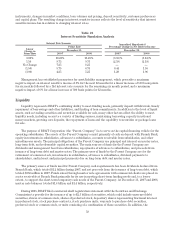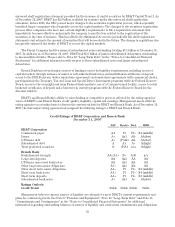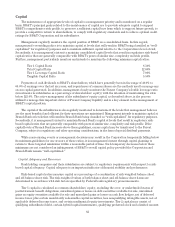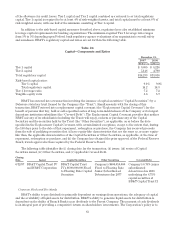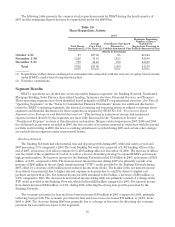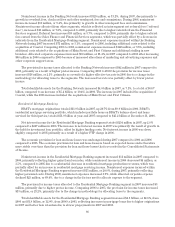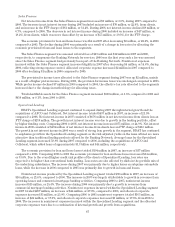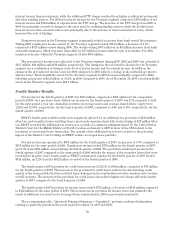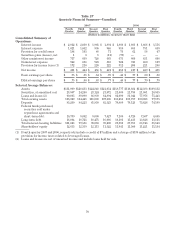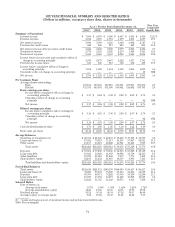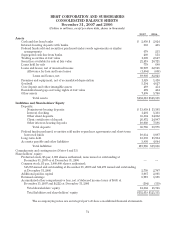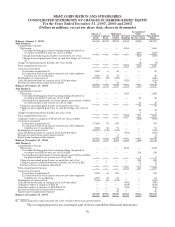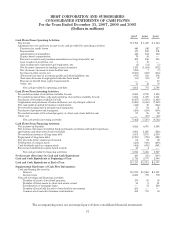BB&T 2007 Annual Report Download - page 67
Download and view the complete annual report
Please find page 67 of the 2007 BB&T annual report below. You can navigate through the pages in the report by either clicking on the pages listed below, or by using the keyword search tool below to find specific information within the annual report.Sales Finance
Net interest income from the Sales Finance segment increased $9 million, or 8.0%, during 2007 compared to
2006. The increase in net interest income during 2007 included an increase of $70 million, or 22.9%, from clients,
and an increase in the FTP charge of $61 million, or 31.4%. During 2006, net interest income declined $8 million, or
6.7%, compared to 2005. The decrease in net interest income during 2006 included an increase of $47 million, or
18.2%, from clients, which was more than offset by an increase of $55 million, or 39.3%, for the FTP charge.
The economic provision for loan and lease losses was flat in 2007 after decreasing $6 million, or 22.2%, in 2006
compared to 2005. The decline during 2006 was primarily as a result of a change in loss rates for allocating the
economic provision for loan and lease losses to the segments.
The Sales Finance segment was assessed referral fees of $13 million and $12 million in 2007 and 2006,
respectively, to compensate the Banking Network for services. 2006 was the first year such a fee was assessed
since the Sales Finance segment had previously been part of the Banking Network. Noninterest expenses
incurred within the Sales Finance segment increased slightly in 2007 after decreasing $4 million, or 14.8%, during
2006, reflecting strong expense control. Allocated corporate expense increased $2 million in 2007 compared to
2006 after declining $1 million in 2006 compared to 2005.
The provision for income taxes allocated to the Sales Finance segment during 2007 was up $2 million, mainly
as a result of higher pretax income. During 2006, the provision for income taxes was unchanged compared to 2005.
While pretax income declined $7 million in 2006 compared to 2005, the effective tax rate allocated to the segments
increased due to the change in methodology for allocating taxes.
Total identifiable assets for the Sales Finance segment increased $300 million, or 5.5%, compared to 2006 and
$410 million, or 8.1%, from 2006 to 2005.
Specialized Lending
BB&T’s Specialized Lending segment continued to expand during 2007 through internal growth and the
acquisitions of AFCO and Collateral. Net interest income totaled $457 million in 2007, an increase of 21.5%
compared to 2006. Net interest income in 2007 consisted of $676 million in net interest income from clients less an
FTP charge of $219 million. The growth in net interest income was due to growth in the lending portfolio, offset
by higher funding costs. Comparing 2006 to 2005, net interest income increased $75 million, or 24.9%. Net interest
income in 2006 consisted of $494 million of net interest income from clients less an FTP charge of $118 million.
The growth in net interest income in 2006 was a result of strong loan growth in the segment. BB&T has continued
to emphasize growth in the Specialized Lending segment as the risk-adjusted yields on the loans offered are more
attractive than traditional lending products offered by the Banking Network. Average loans for the Specialized
Lending segment increased 58.8% during 2007 compared to 2006, including the acquisitions of AFCO and
Collateral, which added loans of approximately $1.3 billion and $44 million, respectively.
The economic provision for loan and lease losses totaled $194 million in 2007, an increase of $57 million
compared to 2006. Comparing 2006 to 2005 the economic provision for loan and lease losses increased $34 million,
or 33.0%. Due to the overall higher credit risk profiles of the clients of Specialized Lending, loss rates are
expected to be higher than conventional bank lending. Loss rates are also affected by shifts in the portfolio mix of
the underlying subsidiaries. The increase during 2007 was primarily due to higher losses on subprime automobile
loans, while the increase in 2006 compared to 2005 was primarily due to growth in loans and leases.
Noninterest income produced by the Specialized Lending segment totaled $90 million in 2007, an increase of
$16 million, or 21.6%, compared to 2006. The increase in 2007 was largely attributable to growth in revenues from
operating leases and commercial mortgage banking activities. Comparing 2006 to 2005, noninterest income
increased $15 million, or 25.4%. The increase during 2006 was primarily due to growth in revenues from
commercial mortgage banking activities. Noninterest expenses incurred within the Specialized Lending segment
in 2007 totaled $207 million, an increase of $44 million, or 27.0%, compared to 2006, and allocated corporate
expenses increased $5 million, or 25.0%. Comparing 2006 to 2005 noninterest expenses totaled $163 million, an
increase of $24 million, or 17.3%, and allocated corporate expenses increased $3 million, or 17.6%, from 2005 to
2006. The increases in noninterest expenses incurred within the Specialized Lending segment and the allocated
corporate expenses were due to a combination of internal growth and growth from acquisitions.
67



